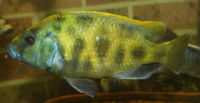Venustus (Nimbochromis venustus)
From The Aquarium Wiki
Revision as of 05:41, 31 March 2021 by 61.9.111.190 (talk)
Venustus
Nimbochromis venustus
322 Litres (85 US G.)
23-25 cm (9.1-9.8")
Freshwater
7.2 - 8.8
25 -27 °C (77-80.6°F)
10-18 °d
1:1 M:F
5-8 years
Family
Cichlidae
Contents
Additional names
- Venustus, Giraffe Hap, Giraffe Haplochromis, Giraffe Cichlid, Venus Cichlid
Additional scientific names
- Cyrtocara venusta, Cyrtocara venustus, Haplochromis simulans, Haplochromis venustus, Nimbochromis venusta
Origin[edit]
- Endemic to Lake Malawi, Africa.
Sexing[edit]
- Mature males are more vivid in colour than females, their head will be more blue in colour.
Tank compatibility[edit]
- This fish should only be kept with similar sized Malawi Cichlids. Are generally not aggressive towards other tank mates but only one male Venustus should be kept to a tank.
Diet[edit]
- A carnivorous fish that should be mainly fed food such as mysis shrimp, ghost shrimp and crickets as well as cichlid pellet and flake. Vegetables in their diet such as blanched lettuce, spinach and peas are beneficial, they may also accept some vegetable based pellet food.
- Please note that this fish is prone to Malawi Bloat and therefore foods such as bloodworm and brine shrimp should be avoided.
Feeding regime[edit]
- Feed once or twice a day.
Environment specifics[edit]
- Provide this fish with a spacious tank with excellent filtration and plenty of hiding places in the form of caves in rock. Make sure the substrate is either fine gravel or sand as this fish may dig in the substrate.
Behaviour[edit]
- A generally peaceful cichlid, although two males may fight to the death over territory.
Identification[edit]
- An large and attractive oval-shaped cichlid. The body is mostly yellow/green while the head is blue, more vivid in the males. The fins vary in colour, either yellow or blue, and several irregular dark blue splotches cover the body, almost in a giraffe-like pattern giving it its common name.
Pictures[edit]
External links[edit]
- Fishbase (Mirrors:
 )
)
- Aqua Hobby
- Aquarium Life.net
- Fish Profiles
- Tims Tropicals (image only)

